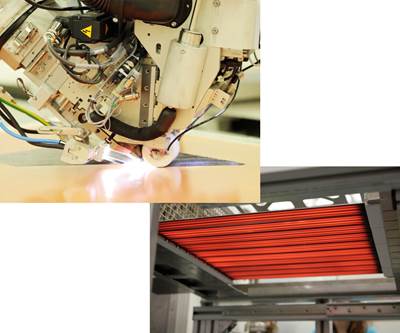VOC-free UV curing prepregs, putties and primer provide effective repair, bonding
CAMX 2024: Sunrez Corp. presents its product line for UV curing, all crafted without VOCs or HAPs for reduced emissions.
Share
Sunrez Corp. (El Cajon, Calif., U.S.) is featuring its custom 7355 VOC-free products for ultraviolet (UV) cure. These products include prepregs, putties and primer. When used in combination, they can effectively repair and bond composite and metal structures in minutes instead of hours, the company reports.
Sunrez’s 7355-vinyl ester prepregs offer single-component pre-impregnated fiberglass fabrics with long-term shelf stability and working time, as well as rapid cure without any requirement for post-cure. Standard fabrics include 1,000 gsm UD, 900 gsm Combi and 800 gsm Biax, as well as chopped strand mat and surf cloths. According to the company, these prepregs are ideal for field repairs where enhanced strength and corrosion resistance are desired.
The Sunrez 1022 primer can provide optimal adhesion to aluminum, steel, ABS, PVC and any composite surface with minimal surface preparation. No VOCs or HAPs are present, so no emissions are created.
All Sunrez products are one-component, so no mixing or wetout is required on-site. No shipment of flammable resins or peroxides are required, as well. Moreover, no special storage requirements are needed because working time is measured in days if the materials are kept out of sunlight. Cure times, either by sunlight or by Sunrez’s UV lights, are said to take less than 10 minutes and are insensitive to temperature changes. No post-cure is needed to achieve a complete cure, according to the company, and its vinyl ester backbone provides enhanced mechanical and thermal properties, as well as optimal chemical resistance and flame spread performance.
These fabrics and mats are available in various customizable sizes, from a few inches up to a full meter in width.
Related Content
-
McLaren celebrates 10 years of the McLaren P1 hybrid hypercar
Lightweight carbon fiber construction, Formula 1-inspired aerodynamics and high-performance hybrid powertrain technologies hallmark this hybrid vehicle, serve as a springboard for new race cars.
-
Natural fiber composites: Growing to fit sustainability needs
Led by global and industry-wide sustainability goals, commercial interest in flax and hemp fiber-reinforced composites grows into higher-performance, higher-volume applications.
-
Sulapac introduces Sulapac Flow 1.7 to replace PLA, ABS and PP in FDM, FGF
Available as filament and granules for extrusion, new wood composite matches properties yet is compostable, eliminates microplastics and reduces carbon footprint.
Related Content
McLaren celebrates 10 years of the McLaren P1 hybrid hypercar
Lightweight carbon fiber construction, Formula 1-inspired aerodynamics and high-performance hybrid powertrain technologies hallmark this hybrid vehicle, serve as a springboard for new race cars.
Read MoreNatural fiber composites: Growing to fit sustainability needs
Led by global and industry-wide sustainability goals, commercial interest in flax and hemp fiber-reinforced composites grows into higher-performance, higher-volume applications.
Read MoreSulapac introduces Sulapac Flow 1.7 to replace PLA, ABS and PP in FDM, FGF
Available as filament and granules for extrusion, new wood composite matches properties yet is compostable, eliminates microplastics and reduces carbon footprint.
Read MorePlant tour: Albany Engineered Composites, Rochester, N.H., U.S.
Efficient, high-quality, well-controlled composites manufacturing at volume is the mantra for this 3D weaving specialist.
Read MoreRead Next
Techonologies for UV curing of composite laminates demonstrated
Racing go-kart project demonstrates advances in UV processing of composites.
Read MoreInnovating energy delivery for more efficient composites manufacturing
Heraeus Noblelight develops HUMM3 and Black IR technologies for faster, safer, more uniform processing.
Read MoreDeveloping bonded composite repair for ships, offshore units
Bureau Veritas and industry partners issue guidelines and pave the way for certification via StrengthBond Offshore project.
Read More












